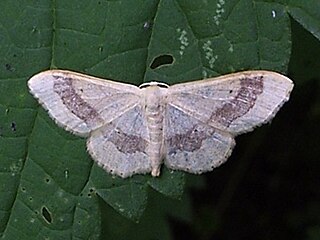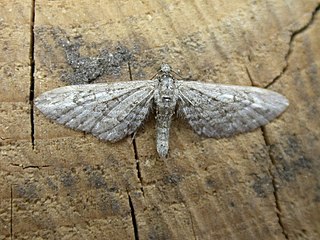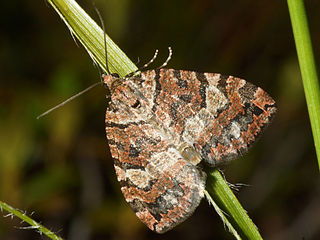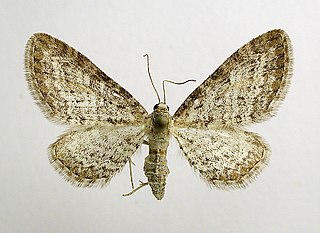
The small fan-footed wave is a moth of the family Geometridae. The species was first described by Johann Siegfried Hufnagel in 1767.

The small dusty wave is a moth of the family Geometridae first described by Franz von Paula Schrank in 1802. It is found throughout Western, Central and Northern Europe. In the north, its range extends as far as Denmark and southern Scandinavia. In the east its range extends as far as Russia. Idaea seriata is replaced by the subspecies Idaea seriata canteneraria, from the north-east of Spain and the central and eastern Mediterranean to the Crimean peninsula, while the western Mediterranean and the Balearic Islands are inhabited by the sister species Idaea minuscularia. Outside Europe it is found in eastern Algeria, Tunisia, Turkey, Cyprus, the Caucasus and the northwest of Transcaucasia. In Morocco and western Algeria, it is replaced by the sister species Idaea minuscularia. In the British Isles it is common in England and Wales but is only found in the eastern half of Scotland and it is rare in Ireland.

The riband wave is a moth of the family Geometridae. The species was first described by Carl Linnaeus in his 1758 10th edition of Systema Naturae.

The mottled pug is a moth of the family Geometridae. The species was first described by Jacob Hübner in 1813. It is found across the Palearctic region apart from around the Mediterranean Sea. It is common in the British Isles apart from Scotland where it is rather local.

The common pug is a moth of the family Geometridae. It is a common species across the Palearctic region, including the Near East and North Africa. It ranges from the Atlantic coast of Ireland and Portugal across Europe, the Middle East and Central Asia to the Russian Far East (Priamurje) and Korea.

The clouded border is a moth of the family Geometridae. The species was first described by Carl Linnaeus in his 1758 10th edition of Systema Naturae. It is distributed across most of Europe to the Urals, western and central Siberia, Transbaikalia, Kazakhstan, Tian-Shan, northern Mongolia and parts of the Near East.

Idaea dimidiata, the single-dotted wave, is a moth of the family Geometridae. It is a Holarctic species.

Lomographa temerata, the clouded silver, is a moth of the family Geometridae. The species is found in Asia and Europe and was first described by Michael Denis and Ignaz Schiffermüller in 1775.

Macaria notata, the peacock moth, is a moth of the family Geometridae. It is a Holarctic species.

Idaea fuscovenosa, the dwarf cream wave, is a moth of the family Geometridae. It is found in the Palearctic.

Idaea straminata, the plain wave, is a moth of the family Geometridae. It is found in Europe including West Russia and Balkans.

Idaea subsericeata, the satin wave, is a moth of the family Geometridae. The species was first described by Adrian Hardy Haworth in 1809. It is found from central and southern Europe, North Africa, Asia Minor to Transcaspia.

Eupithecia nanata, the narrow-winged pug, is a moth of the family Geometridae. The species was first described by Jacob Hübner in 1813. It can be found all over Europe including Russia and Ukraine. In the Alps it occurs up to 2,200 metres (7,200 ft) above sea level and in the Pyrenees to 2400 meters. The species prefers dry or boggy heathlands.

Jodis lactearia, the little emerald, is a moth of the family Geometridae. The species was first described by Carl Linnaeus in his 1758 10th edition of Systema Naturae. It is found throughout the Palearctic realm, from Ireland to Japan.

Hydriomena furcata, the July highflyer, is a moth of the family Geometridae. The species was first described by Carl Peter Thunberg in 1784. It is found in the Holarctic ecozone.

Mesotype didymata, the twin-spot carpet, is a moth of the family Geometridae. The species was first described by Carl Linnaeus in his 1758 10th edition of Systema Naturae. Its genus is sometimes included in Perizoma.

Acasis viretata, the yellow-barred brindle, is a moth of the family Geometridae. The species was first described by Jacob Hübner in 1799. It is found across most of Europe and throughout the Palearctic to Korea. In northern India it is represented by Acacis viretata himalayica. It is also present in North America. This species occurs in many different habitats, including deciduous and mixed forests, rocky slopes and valleys, as well as bushy meadows, bogs and taiga areas. In the Alps, it can still be found at an altitude of 1700 meters.

Eupithecia subumbrata, the shaded pug, is a moth of the family Geometridae. The species was first described by Michael Denis and Ignaz Schiffermüller in 1775. It is found from Mongolia and the Altai Mountains through Siberia, central Asia, Asia Minor and Russia to western Europe and from central Scandinavia to the Mediterranean region.

Hydriomena ruberata, the ruddy highflyer, is a moth of the family Geometridae. The species was first described by Christian Friedrich Freyer in 1831. It is found from Ireland and Great Britain east to north-western Russia, and south up to the Alps. It is also present in North America.

Lampropteryx suffumata, the water carpet, is a moth of the family Geometridae. It is found from Europe to the Altai Mountains, Khabarovsk Krai and the Kamchatka Peninsula in the far east of Russia, and Hokkaido, Japan. In 2000, the species was discovered in Alaska, USA, and then in 2008 DNA-barcoding analysis of museum specimens identified several Canadian specimens, thereby extending the geographical range from Ireland in the west, across Eurasia, to the west of North America. The habitat consists of damp woodland, grassy areas, chalk downland and scrubland.






















